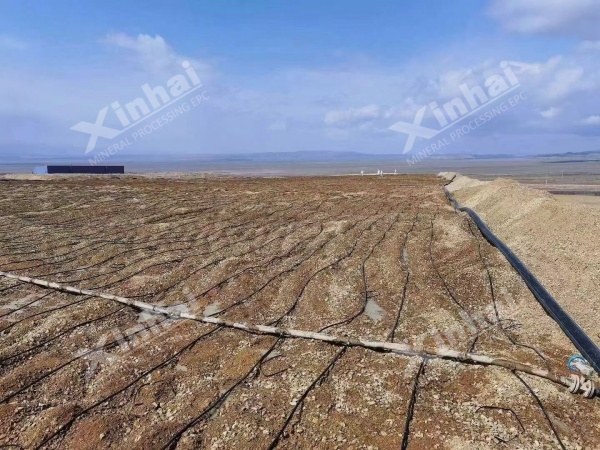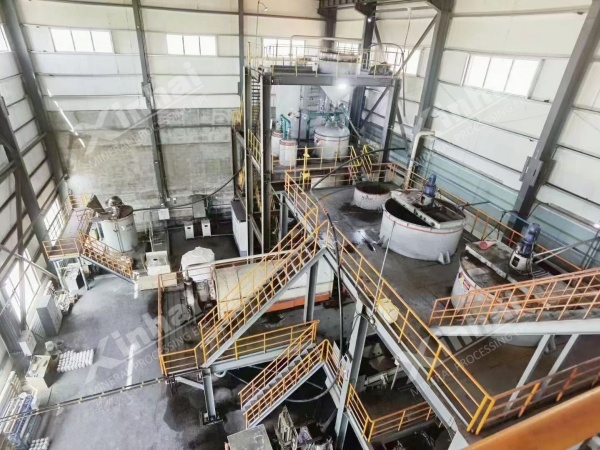If you want to know more information (such as product/process price, etc.), please contact us 24-hour telephone
As international gold prices continue to rise, low-grade gold resources that
were previously overlooked are being re-evaluated. Common gold extraction
processes include flotation, cyanidation, and heap leaching, most of which
require ores with a relatively high gold grade to be economically viable. For
low-grade gold ores, typically with grades below 1 g/t, traditional processing
methods often become uneconomical due to high costs.
In such cases, heap leaching is a recommended technique due to its low capital investment, low operating costs, and strong adaptability to ore types. It has become a key technology for the economical development of low-grade gold deposits.

1. Strong Applicability
The heap leaching process is particularly suitable for surface oxide ores, low-grade ores (typically<1 g/t), and ores with low clay (slime) content.
2. Low Cost
The heap leaching process features a relatively simple flowsheet, eliminating the need for complex grinding, flotation, or conventional cyanidation plant construction. With fewer equipment requirements, capital investment is typically only 30%–50% of that required for traditional gold processing plants.
Operational costs are also relatively low due to the absence of high-energy grinding circuits, reduced reagent consumption, and lower labor demand.
3. Controllable Environmental Risks
Heap leaching is conducted in a closed and engineered leach pad equipped with an impermeable liner system, which effectively contains the leaching solution and prevents environmental contamination of water and soil resources.
Note: Despite its many advantages, the heap leaching process is not universally applicable. For instance, refractory sulfide ores with gold encapsulated in sulfide minerals require pre-treatment (e.g., roasting, pressure oxidation, or bio-oxidation) prior to leaching. Additionally, ultra-fine tailings are generally not suitable for heap leaching due to poor permeability.

In 2024, Xinhai Mining undertook a heap leaching project at a gold mine in Malaysia, with a designed processing capacity of 95,000 tons per month. Using this project as an example, we present the process flow of heap leaching gold extraction.
General Process Flow:
Raw ore screening → Granulation of fine materials → Heap construction and solution application (drip irrigation) → Pregnant solution collection and adsorption → Desorption and electrolysis → Smelting → Final gold ingots.
1. Crushing and Screening
The surface ore is oxidized and does not require primary crushing. Raw ore is directly fed into the ore bin and then conveyed to a round vibrating screen via a belt feeder and belt conveyor. Oversized material (8–50 mm) is transported to the stacking yard for heap construction. Undersized material (0–8 mm) is sent to a buffer bin before granulation.
2. Granulation
The undersized screened ore is conveyed from the buffer bin to a drum granulator via a belt feeder and belt conveyor. After granulation, the material is stockpiled in preparation for heap leaching.
3. Heap Construction Design
This project processes approximately 95,000 tons of ore per month. The heap leaching pad covers an area of about 15,000 square meters, with a single-layer heap height of 5 meters. A single-layer leaching method is adopted, with two heap areas operated alternately. For more flexible management and efficient leaching, each ore heap is divided into two separate drip-leaching zones.

4. Heap Construction Plan
The ore is transported to the heap leaching pad via a mobile belt conveyor and stacked using a parallel, forward-moving, layered, and partitioned heap construction method. Once the ore heap is formed, the surface is fully loosened using an excavator equipped with a ripper, penetrating to a depth of more than 1 meter.
5. Pregnant Solution Pond, Barren Solution Pond, and Stormwater Collection Pond Design
Barren and Pregnant Solution Ponds:
Both ponds are designed with an effective volume of 1,800 m³, providing approximately 12 hours of buffer capacity. A 1.5 mm HDPE geomembrane is used for anti-seepage lining.
Stormwater Collection Pond:
Constructed based on the natural site topography, usually positioned at the downstream catchment point surrounding the leach pad. The pond is excavated and lined with a 1.5 mm HDPE geomembrane to ensure leak prevention.
6. Pipeline Layout
Pipelines are laid out based on the ore heap layout. The main pipeline runs along the center of the ore pile, with drip irrigation manifolds branching symmetrically to both sides.
7. Drip Irrigation Leaching
Solution Concentration Control:
Cyanide concentration is strictly managed—high in the early stage, slightly lower in the middle stage, and lowest in the final month. Dosage is calculated based on the barren solution pond capacity. If mid-process adjustments are needed, both cyanide concentration and volume must be measured to recalculate dosing.
Leaching Intensity Control:
Ensure even and full surface coverage of the ore heap without waterlogging.
pH Maintenance:
The pH of the pregnant solution collected should be maintained between 9 and 11 to ensure effective leaching and reduce cyanide volatilization.

8. Carbon Adsorption System
The pregnant solution is pumped from the pregnant solution pond to the carbon adsorption tanks in the adsorption workshop. When the barren solution’s gold content begins to rise, carbon replacement is initiated to ensure maximum gold recovery from the solution.
9. Spent Ore (Tailings) Handling
The leach pad is a permanent stacking site. After each leaching cycle, the ore heap must be unloaded.
Before unloading:
Stop cyanide addition;
Rinse the heap thoroughly with clean water to recover residual gold;
Apply bleaching powder to the surface and continue rinsing to neutralize residual cyanide;
Repeat until the rinse water meets environmental discharge standards.
10. Desorption and Electrolysis
The gold-loaded carbon is transferred to the desorption column, where cyanide-free desorption occurs under high temperature and pressure. The pregnant solution is circulated and electrolyzed simultaneously. Upon completion, the system is cooled and gold mud is collected. Sampling and testing of the solution during the process help monitor desorption efficiency.
11. Smelting
The gold mud undergoes acid washing, impurity removal, filtration, and melting in a gold furnace. The final product—gold ingots—has a purity of approximately 90%.

With over 30 years of deep cultivation in the mining industry, Xinhai Mining has served more than 2,000 mines worldwide, offering comprehensive mining services including mine design, equipment manufacturing and installation, engineering construction, equipment commissioning, and beneficiation plant operation—forming a full industry chain service model (EPCM+O). Xinhai has successfully undertaken numerous gold heap leaching projects. Our core advantages include:
1. Strong Technical Expertise
Xinhai Mining Design Institute employs over 80 skilled professionals across disciplines such as geology, mineral processing, mechanical engineering, automation, and more—ensuring that clients receive scientific, tailored beneficiation solutions.
2. Robust Equipment Manufacturing Capability
Xinhai possesses independent R&D and equipment manufacturing capabilities. Its intelligent production base, located in Yantai, Shandong Province, China, produces high-quality, reliable mineral processing equipment based on years of technological innovation and practical application.

3. Full-Process EPC Delivery
Xinhai offers one-stop EPC services, from feasibility studies and detailed design to project commissioning and production. We apply 3D collaborative design (BIM), modularized equipment installation, and an intelligent drip irrigation control system powered by IoT remote monitoring—enhancing project speed and stability.
4. Operational Performance Commitment
Xinhai develops customized process flows based on comprehensive mineral processing test results and takes responsibility for achieving the target recovery rate. A dedicated team of engineers is deployed on-site to oversee operations, optimize reagent dosing and process parameters in real time, and ensure stable, efficient production aligned with client expectations.
If you are exploring the development of a low-grade gold mine and are unsure how to proceed, contact Xinhai for professional guidance and customized solutions!